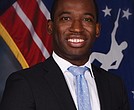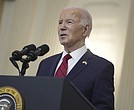A more perfect union
City reaches negotiated agreement regarding collective bargaining
Jeremy M. Lazarus | 7/21/2022, 6 p.m.
Collective bargaining is coming to City Hall for the first time – though it could take a year or more to have an impact.
Next Monday, July 25, City Council is expected to easily approve a landmark ordinance allowing most city employees who are not in managerial or supervisory positions to participate in unions that would bargain on their behalf with the city on wages and other issues and represent them in disciplinary actions.
At this point, all nine council members have signed on as supporters of the legislation as has Mayor Levar M. Stoney, who finally dropped his seven-month effort to sharply limit the number of employees allowed to organize.
Passage will be a history-making moment that a significant number of employees believe will allow them to finally gain, as one put it, “a seat at the table” to negotiate health and safety issues as well as wages.
Public employee unions became possible in Virginia after the General Assembly removed the prohibition on collective bargaining for workers at the local government level. The law went into effect in May 2021.
Mayor Stoney announced the agreement on the ordinance with praise for the collaboration between the council and administration that produced a “responsive and responsible collective bargaining ordinance” that would benefit “our workers and our citizens.”
The final wording was approved July 15 after a last-minute negotiating session that lasted two hours.
The council vote is just the first step. Based on the timetables in the ordinance, the first talks between a union and the city are considered unlikely to take place before late spring or early summer next year.
For one, organizations that want to represent a group of employees must wait at least four months to request an election to become the recognized bargaining agent. The request needs to be accompanied by evidence that at least 30 percent of employees eligible to vote in that bargaining unit want that particular organization to negotiate for them.
Before any vote can take place, the city also must hire a neutral labor relations administrator (LRA) to write the policies and procedures, including those involved in holding an election.
The city has four months to hire an LRA or must work with unions to hire a temporary administrator to handle that work until a permanent administrator is hired.
Once rules are in place, it could then take 45 to 60 days for the administrator to organize and hold a mail-in election and certify the results – meaning, at the earliest, February or March 2023, or smack-dab in the middle of the development with the council of the 2023-24 budget.
Whether the administration would start holding contract talks immediately or wait until June when the budget process would be complete remains to be seen, but that is anticipated.
Development of the first contract would need to be completed by Dec. 1 for any proposals with a budget impact to be incorporated into the mayor’s proposed budget 2024-25 budget, the ordinance states. The ordinance also sets out a process for settling disagreements.
However, any tentative agreement between a union and the mayor’s administration would not go into effect until City Council voted to accept the terms, particularly those with a budget impact. Council also could reject the tentative agreement.
The ordinance, though, only applies to employees of departments that report to the chief administrative officer and the mayor.
Despite the whole-hearted council support, members of the governing body made sure that neither its appointees nor any employees who work for the auditor, city assessor, city attorney, inspector general, city clerk, council chief of staff or other appointees could organize.
Employees of the sheriff and other constitutional officers as well as the courts, all state employees, also would be barred from participating in a city union. The new ordinance also would block employees in the Human Resources and Budget departments from securing union representation.
Still, the Virginia AFL-CIO is gleeful that Richmond is on its way to becoming a union bastion after a seven-decade fight to make it possible.
“We are proud to see a collective bargaining ordinance come out of our capital city,” stated Doris Crouse-Mays, president of the state’s largest union organization. “This will be a great step in improving the lives of city employees and the people they serve.”
The ordinance is modeled after ones that several Northern Virginia localities approved last year, which are still in various stages of implementation.
The city also is following in the footsteps of the Richmond School Board, which last year became the first school district in Virginia to authorize employee unions.
Three members of council are credited with spearheading the ordinance, Kristen M. Nye, 4th District, Reva M. Trammell, 8th District, and Stephanie A. Lynch, 5th District.
People close to the talks said that it would not have happened without Ms. Nye.
“This compromise creates a solid foundation for city employees to advocate for competitive pay and benefits and continue their service to our residents,” Ms. Nye, chair of council’s Governmental Operations Committee that led the effort, stated.
“This agreement marks a significant step forward for the City of Richmond and its employees,” added Ms. Trammell, who also is credited with ensuring emergency dispatchers could be part of a union representing fire employees.
“I have championed our employees for years,” Ms. Lynch stated. Several people who were involved said Ms. Lynch played a critical role in bringing the parties together and in securing compromise language on key items that produced legislation in time to vote on the final meeting in July. “I am ecstatic to have my colleagues reach an agreement that benefits employees.”
While union advocates gained most of the wording they sought, Local 512 of the Service Employees International Union lost its bid to have just three bargaining units, one for police officers, one for firefighters and one for other city employees.
At Ms. Trammell’s insistence, those involved say, the ordinance authorizes five bargaining units, one for police, one for fire, one for labor and trades workers, one for professionals, and one for administrative and technical employees, all of which could be represented by different unions.
The city’s chief administrative officer, Lincoln Saunders, previously unenthusiastic about having multiple bargaining units, waxed enthusiastic in the mayor’s statement.
“This ordinance signals to our employees that we hear them,” Mr. Saunders stated, “as we strive to make the city government a workplace of choice.”
To Council President Cynthia I. Newbille, the ordinance had to move forward.
“Collective bargaining was something that our employees not only want but need,” she stated. “Strengthening our employees strengthens our city.”










